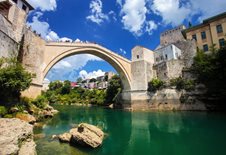
Encountering the Old Bridge of the Bosnian town of Mostar in the seventeenth-century, a Muslim traveler resorted to hyperbole to describe region’s most iconic monument:
The bridge is like a rainbow arch soaring up to the skies, extending from one cliff to the other...I, a poor and miserable slave of Allah, have passed through sixteen countries, but I have never seen such a high bridge. It is thrown from rock to rock as high as the sky.”
The Old Bridge — or “Stari Mosta” in Mostar (which means literally “guardians of the bridge”) has always seemed more symbol than conveyance, and no more so than in its most recent iteration.
The bridge spanned the icy waters of the Nevetva, linking two sides of a town that became a byword for multiculturalism during centuries of Ottoman, and later Austro-Hungarian rule. Located at a strategic junction on the lucrative trade route between the ports of the Adriatic and Bosnia, with its rich natural resources, the bridge was crucial to the growth and development of Mostar, which became an important commercial and political hub of the region.
The Old Bridge was commissioned by the most famous of the Ottoman rulers, Suleiman the Magnificent (1494-1566), in 1557. The Sultan spent a whopping 300,000 silver pieces to replace a rickety wooden and rope bridge with a more serviceable stone edifice. Architect Mimar Hayruddin’s striking “humpbacked” design, similar to those seen in Venice, creates the dramatic — almost magical — optical effect of a complete ellipse when the bridge is reflected in the water. At such moments, both the Old Bridge and Mostar seem like the movie set of a fairytale film.
For almost five centuries, the bridge conveyed the Muslims, Jews, Catholic and Orthodox Christians between the old city and the newer commercial center, proudly surviving the upheaval of the break-up of the Ottoman Empire and the carnage of two world wars. In 1992, however, the bridge was tragically caught between the crossfire of the War in Bosnia and Herzegovina, and blown up in November of that year.
Even as the bridge’s ancient stones sunk to the bottom of the Nevetva, plans were underway to restore Mostar’s most iconic landmark. Spearheaded by Mostar architect and Islamic architecture historian, Amir Pasić, the eventual restoration brought together an international coalition of architects, engineers, construction experts, historians, and eager amateur volunteers from many different countries. $15.5 million dollars was eventually raised by donations from the World Bank, UNESCO, the Aga Khan Foundation and the governments of Turkey and Italy. Hungarian divers recovered many of the original stones at the bottom of the river and after four years of dedicated work, the Old Bridge once again bridges the divide between east and west: a much-needed and potent symbol of reunification and reconciliation for multi-cultural Mostar and the Bosnian-Herzegovinian people.
Learn more about the fascinating history and culture of the Southeastern Europe on one of Alexander + Roberts’s popular itineraries such as
Journey to Croatia & Montenegro, which visits 8 UNESCO World Heritage Sites, including Mostar.